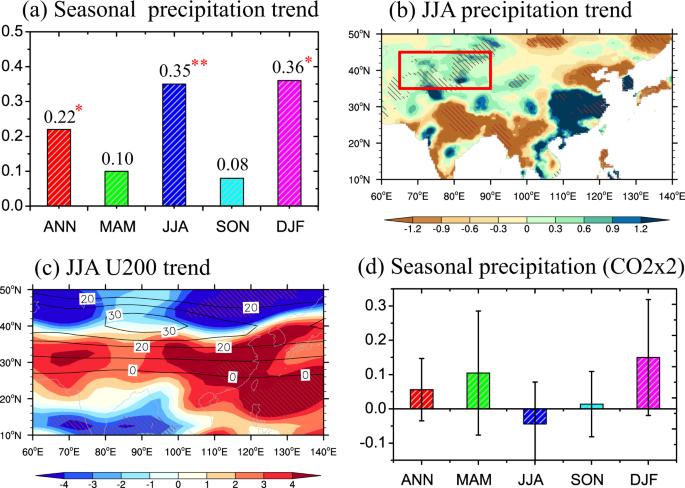Anthropogenic sulfate aerosol pollution in South and East Asia induces increased summer precipitation over arid Central Asia
IF 8.1
1区 地球科学
Q1 ENVIRONMENTAL SCIENCES
引用次数: 1
Abstract
Precipitation has increased across the arid Central Asia region over recent decades. However, the underlying mechanisms of this trend are poorly understood. Here, we analyze multi-model simulations from the Precipitation Driver and Response Model Intercomparison Project (PDRMIP) to investigate potential drivers of the observed precipitation trend. We find that anthropogenic sulfate aerosols over remote polluted regions in South and East Asia lead to increased summer precipitation, especially convective and extreme precipitation, in arid Central Asia. Elevated concentrations of sulfate aerosols over remote polluted Asia cause an equatorward shift of the Asian Westerly Jet Stream through a fast response to cooling of the local atmosphere at mid-latitudes. This shift favours moisture supply from low-latitudes and moisture flux convergence over arid Central Asia, which is confirmed by a moisture budget analysis. High levels of absorbing black carbon lead to opposing changes in the Asian Westerly Jet Stream and reduced local precipitation, which can mask the impact of sulfate aerosols. This teleconnection between arid Central Asia precipitation and anthropogenic aerosols in remote Asian polluted regions highlights long-range impacts of anthropogenic aerosols on atmospheric circulations and the hydrological cycle. An equatorward shift in the Asian Westerly Jet Stream attributable to high levels of anthropogenic sulfate aerosol in South and East Asia favours the moisture supply from low-latitudes and moisture flux convergence over arid Central Asia, according to multi-model data analysis.

南亚和东亚的人为硫酸盐气溶胶污染导致中亚干旱地区夏季降水增加
近几十年来,整个中亚干旱地区的降水量都在增加。然而,人们对这一趋势的内在机制知之甚少。在此,我们分析了降水驱动因素和响应模式相互比较项目(PDRMIP)的多模式模拟,以研究观测到的降水趋势的潜在驱动因素。我们发现,南亚和东亚偏远污染地区上空的人为硫酸盐气溶胶导致中亚干旱地区夏季降水增加,尤其是对流性降水和极端降水。受污染的亚洲偏远地区上空硫酸盐气溶胶浓度升高,通过对中纬度局地大气冷却的快速反应,导致亚洲西风喷流向赤道移动。这种偏移有利于低纬度地区的水汽供应和中亚干旱地区的水汽流量汇聚,水汽预算分析证实了这一点。高浓度的吸收性黑碳会导致亚洲西风喷流发生相反的变化,并减少当地降水,从而掩盖硫酸盐气溶胶的影响。中亚干旱地区的降水与亚洲偏远污染地区人为气溶胶之间的这种远距离联系凸显了人为气溶胶对大气环流和水文循环的长程影响。根据多模式数据分析,南亚和东亚的高浓度人为硫酸盐气溶胶导致亚洲西风喷流向赤道移动,有利于低纬度地区的水汽供应和中亚干旱地区的水汽流量汇聚。
本文章由计算机程序翻译,如有差异,请以英文原文为准。
求助全文
约1分钟内获得全文
求助全文
来源期刊

Communications Earth & Environment
Earth and Planetary Sciences-General Earth and Planetary Sciences
CiteScore
8.60
自引率
2.50%
发文量
269
审稿时长
26 weeks
期刊介绍:
Communications Earth & Environment is an open access journal from Nature Portfolio publishing high-quality research, reviews and commentary in all areas of the Earth, environmental and planetary sciences. Research papers published by the journal represent significant advances that bring new insight to a specialized area in Earth science, planetary science or environmental science.
Communications Earth & Environment has a 2-year impact factor of 7.9 (2022 Journal Citation Reports®). Articles published in the journal in 2022 were downloaded 1,412,858 times. Median time from submission to the first editorial decision is 8 days.
 求助内容:
求助内容: 应助结果提醒方式:
应助结果提醒方式:


